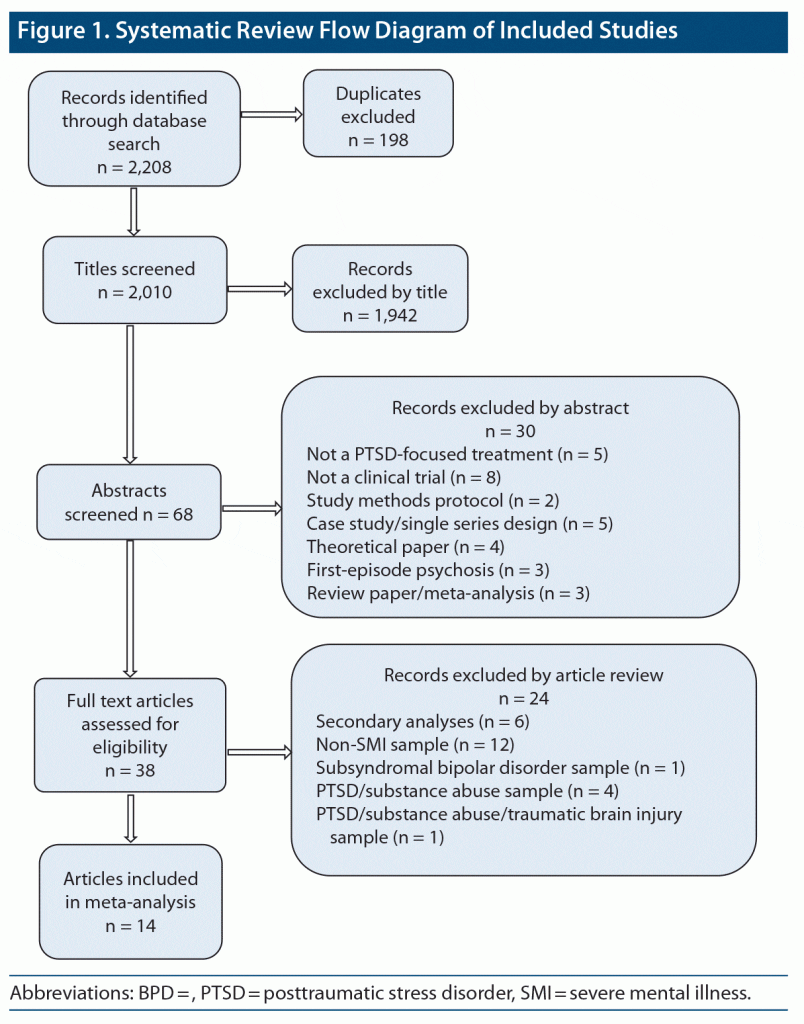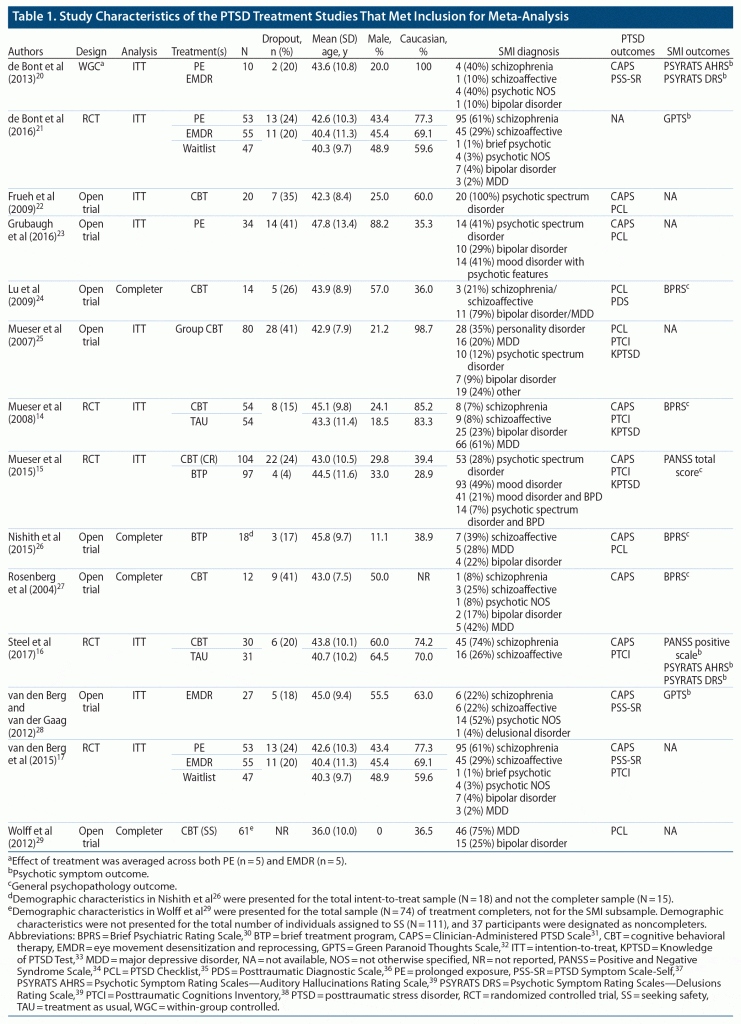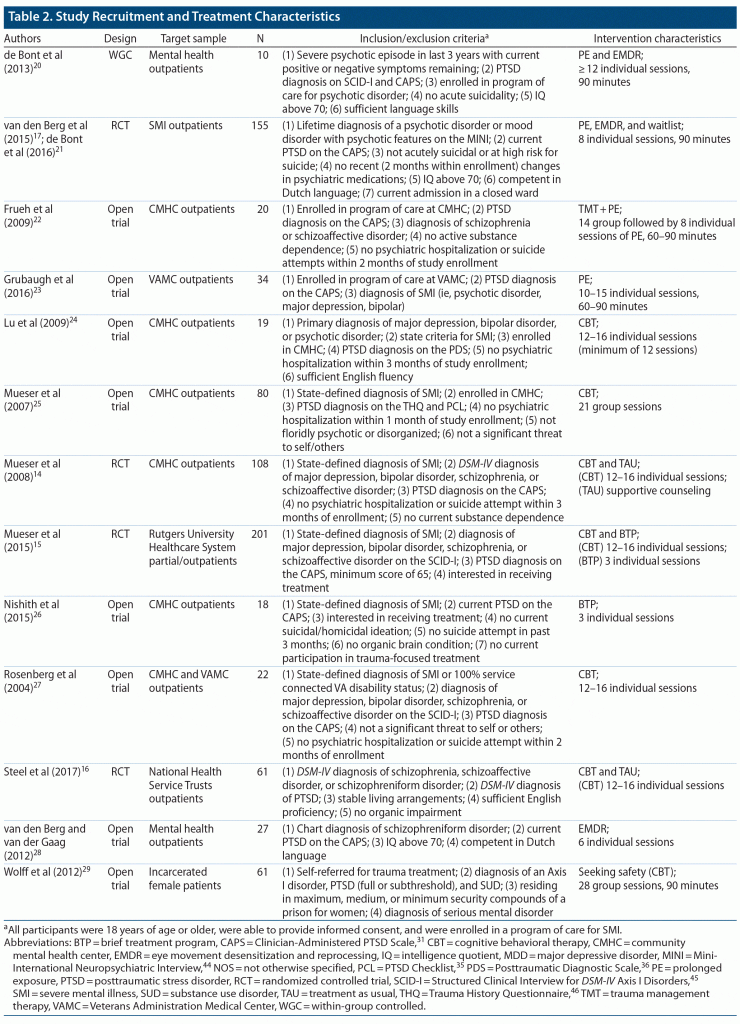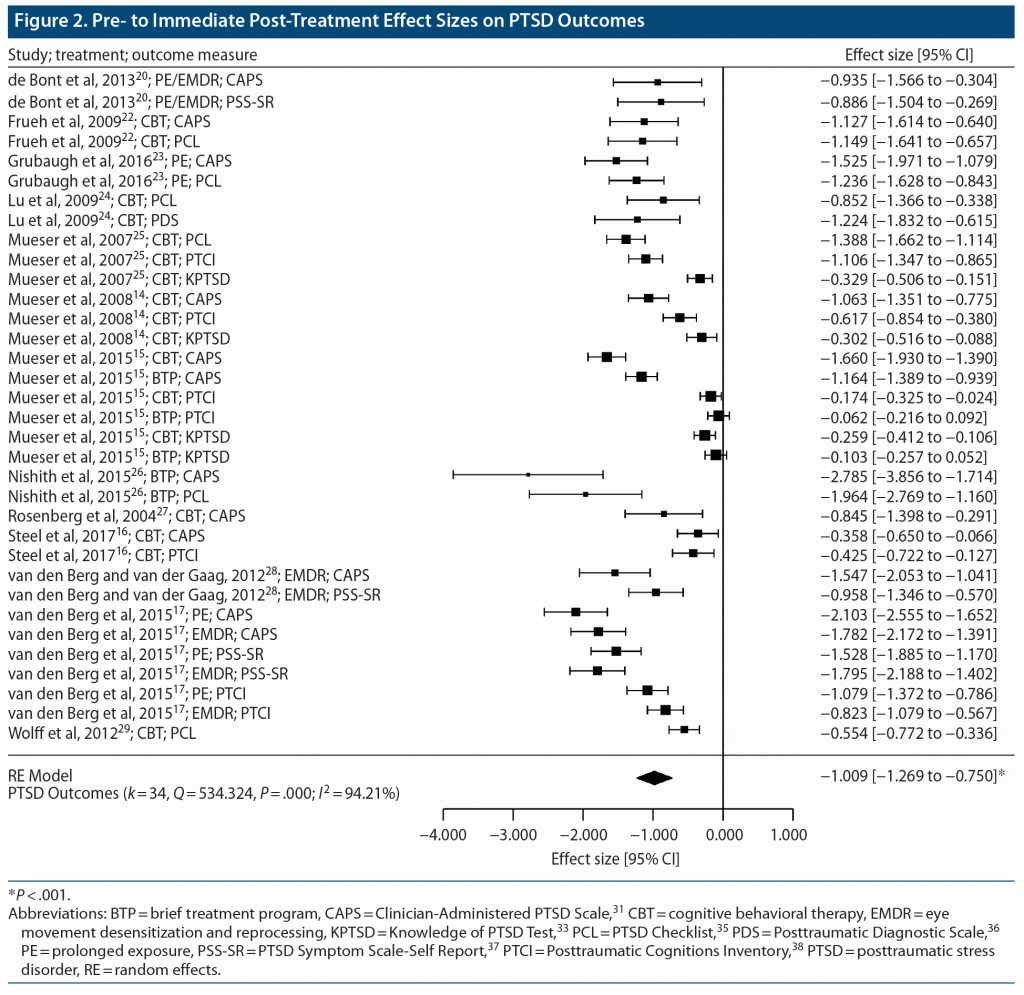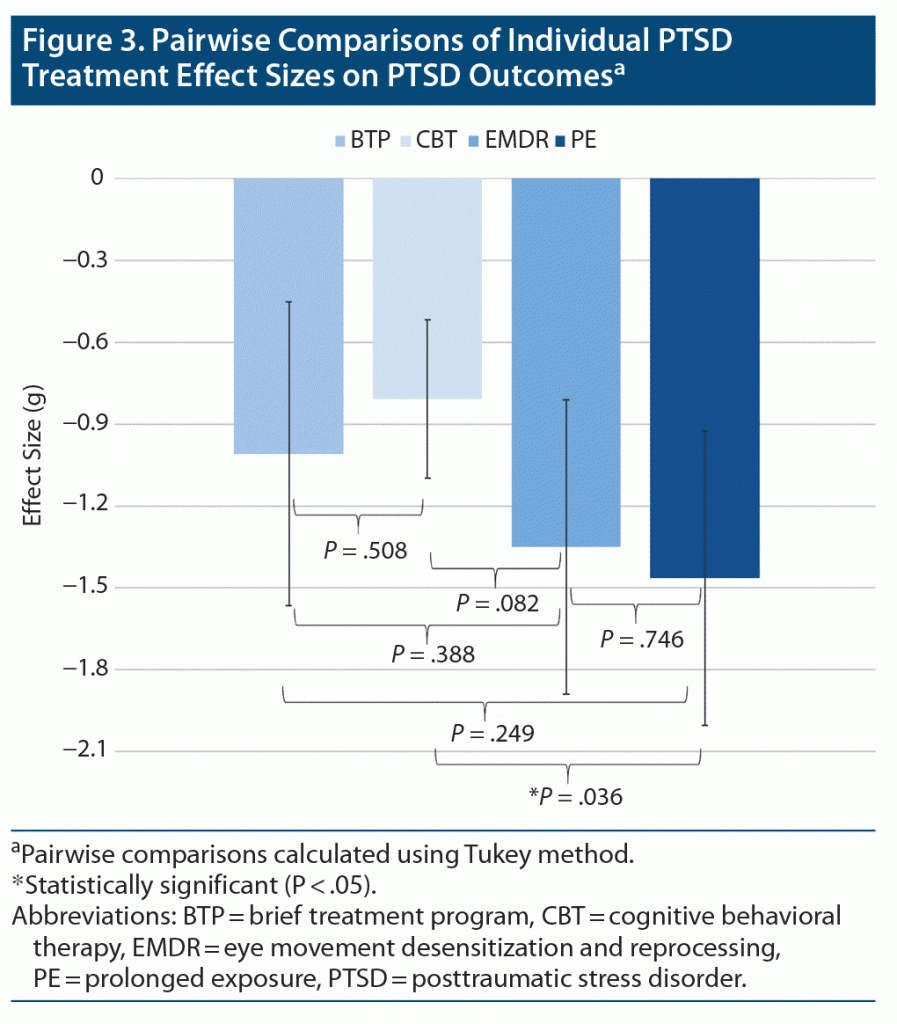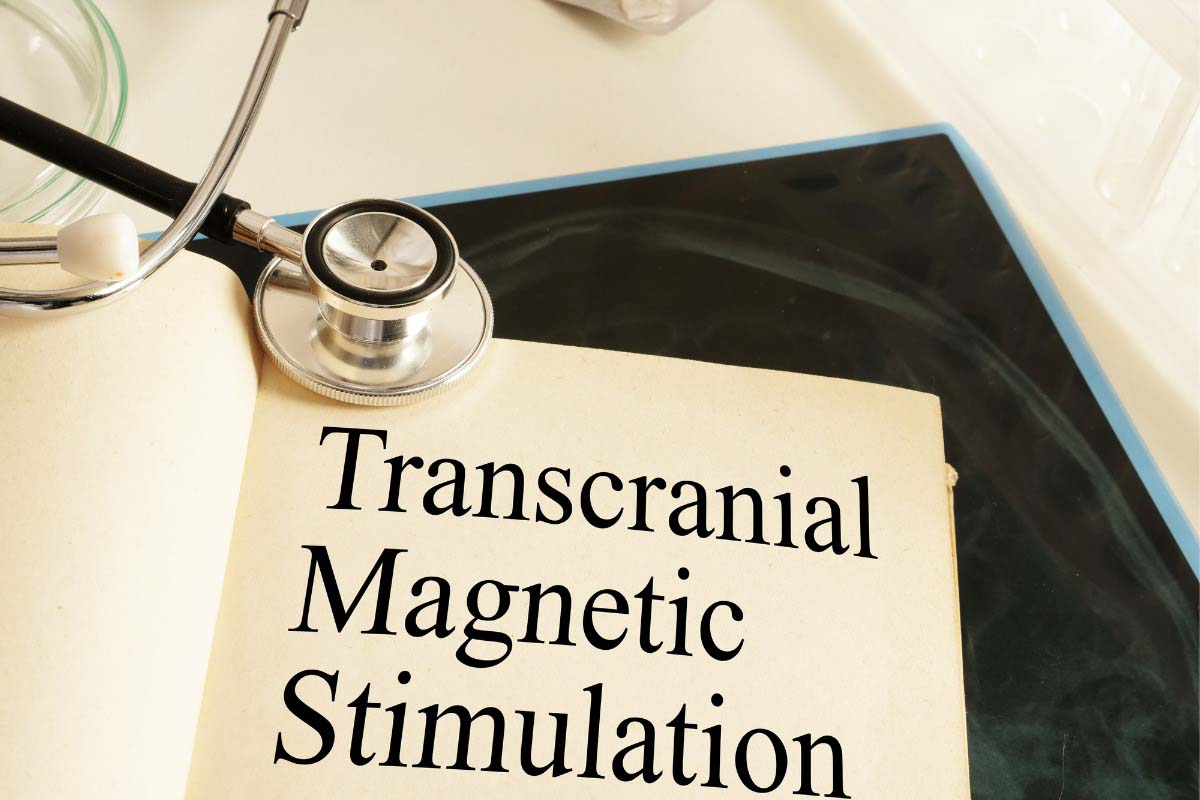ABSTRACT
Objective: To evaluate the efficacy of psychosocial treatments for posttraumatic stress disorder (PTSD) among individuals with a comorbid severe mental illness (SMI; ie, schizophrenia, bipolar disorder, major depressive disorder).
Data Sources: PubMed, PsycINFO, CINAHL, and Cochrane Library were searched from January 1998 to March 2020 using keywords related to PTSD, treatment, and severe mental illness.
Study Selection: All clinical trials for PTSD psychotherapy among individuals with SMI were included. From 38 potentially eligible studies, a total of 14 clinical trials across 684 individuals with comorbid SMI and PTSD were identified and included in the analysis.
Data Extraction: Data on demographic, SMI diagnosis, symptom severity, sample attrition, and treatment protocol received were extracted. Effect size calculations and subsequent meta-analyses were conducted using the Meta-Analysis Package for R (metafor) version 2.1–0 in R (3.6.0).
Results: PTSD treatments had a large effect on PTSD outcomes among individuals with SMI, with patients experiencing a standard deviation reduction in PTSD symptomatology pre- to post-treatment (g = −1.009, P < .001, k = 34). Prolonged exposure (g = −1.464; P < .001; SE = 0.276; k = 5), eye movement desensitization and reprocessing (g = −1.351; P < .001; SE = 0.276; k = 5), and brief treatment program (g = −1.009; P < .001; SE = 0.284; k = 5) had the largest effects on PTSD symptoms.
Conclusions: Although underrepresented in the PTSD literature, PTSD psychotherapies are effective for individuals with SMI. Treatments with an exposure-based component may have greater efficacy in this clinical population.
J Clin Psychiatry 2021;82(3):20r13584
To cite: Grubaugh AL, Brown WJ, Wojtalik JA, et al. Meta-analysis of the treatment of posttraumatic stress disorder in adults with comorbid severe mental illness. J Clin Psychiatry. 2021;82(3):20r13584.
To share: https://doi.org/10.4088/JCP.20r13584
© Copyright 2021 Physicians Postgraduate Press, Inc.
aRalph H. Johnson Veterans Affairs Medical Center and Department of Psychiatry and Behavioral Sciences, Medical University of South Carolina, Charleston, South Carolina
bSchool of Humanities and Social Sciences, Pennsylvania State University, The Behrend College, Erie, Pennsylvania
cJack, Joseph, & Morton Mandel School of Applied Social Sciences, Case Western Reserve University, Cleveland, Ohio
dSchool of Social Work, University of Pittsburgh, and Department of Psychiatry, University of Pittsburgh School of Medicine, Pittsburgh, Pennsylvania
*Corresponding author: Anouk L. Grubaugh, PhD, Department of Psychiatry and Behavioral Sciences, Medical University of South Carolina, PO Box 250861, Charleston, SC 29425 ([email protected]).
Find more articles on this and other psychiatry and CNS topics:
The Journal of Clinical Psychiatry
The Primary Care Companion for CNS Disorders
CME Background
Articles are selected for credit designation based on an assessment of the educational needs of CME participants, with the purpose of providing readers with a curriculum of CME articles on a variety of topics throughout each volume. Activities are planned using a process that links identified needs with desired results.
To obtain credit, read the article, correctly answer the questions in the Posttest, and complete the Evaluation. This activity is free.
CME Objective
After studying this article, you should be able to:
- Use evidence-based psychotherapies for PTSD whether or not patients have comorbid bipolar disorder or schizophrenia
Accreditation Statement
The CME Institute of Physicians Postgraduate Press, Inc., is accredited by the Accreditation Council for Continuing Medical Education to provide continuing medical education for physicians.
Credit Designation
The CME Institute of Physicians Postgraduate Press, Inc., designates this journal-based CME activity for a maximum of 1 AMA PRA Category 1 Credit™. Physicians should claim only the credit commensurate with the extent of their participation in the activity.
Note: The American Nurses Credentialing Center (ANCC) and the American Academy of Physician Assistants (AAPA) accept certificates of participation for educational activities certified for AMA PRA Category 1 Credit™ from organizations accredited by the ACCME.
Release, Expiration, and Review Dates
This educational activity was published in May 2021 and is eligible for AMA PRA Category 1 Credit™ through June 30, 2023. The latest review of this material was May 2021.
Financial Disclosure
All individuals in a position to influence the content of this activity were asked to complete a statement regarding all relevant personal financial relationships between themselves or their spouse/partner and any commercial interest. The CME Institute has resolved any conflicts of interest that were identified. In the past year, Marlene P. Freeman, MD, Editor in Chief, has received research funding from JayMac and Sage; has been a member of the advisory boards for Otsuka, Alkermes, and Sunovion; and has been a member of the Independent Data Safety and Monitoring Committee for Janssen. No member of the CME Institute staff reported any relevant personal financial relationships. Faculty financial disclosure appears at the end of the article.
The efficacy of evidence-based treatments (EBTs) for posttraumatic stress disorder (PTSD) in the general population is well established in the extant literature. To date, the most robust and well-supported interventions for PTSD include prolonged exposure (PE), eye movement desensitization and reprocessing therapy (EMDR), and cognitive processing therapy (CPT), with pre- to post-treatment PTSD symptom effect sizes (ESs) ranging from 1.43 to 2.74 (Cohen d) and active and control group post-treatment ESs ranging from 1.01 to 1.63 (Hedges g).1–4 Additional meta-analytic findings suggest that EBTs for PTSD are generally comparable to one another with regard to efficacy, treatment nonresponse, and attrition. More specifically, approximately 70% of patients who receive a standard course of PE, CPT, or EMDR experience significant symptom reduction or loss of diagnosis at follow-up. Conversely, approximately 30% of patients who receive a standard course of an EBT for PTSD do not respond, and up to 50% drop out of treatment prematurely without significant symptom improvement.4–6 Taken together, meta-analytic findings suggest that EBTs for PTSD are effective if a patient receives a sufficient dose of the intervention.
Although the efficacy of EBTs for PTSD in the general population is well documented, far less is known regarding how these same interventions perform with more complicated patient populations, such as those with comorbid forms of severe mental illness (SMI; ie, schizophrenia, bipolar disorder). This is significant because documented rates of PTSD are higher among individuals with SMI relative to the broader population. For example, 2 recent reviews on the prevalence of PTSD in patients with a schizophrenia spectrum disorder7,8 found rates of PTSD as high as 55% and 57%, respectively. In one review, a PTSD prevalence of at least 10% was observed in 30 (78.9%) of the 38 studies examined.7 In another review on the comorbidity between bipolar affective disorder and anxiety disorders, the authors found a 10.8% lifetime prevalence of PTSD.9 These rates contrast significantly with the 6.8% lifetime prevalence of PTSD found in the general population.10 Such findings are noteworthy because the presence of both PTSD and SMI is linked with significantly worse outcomes across a range of clinical, functional, and quality of life indices relative to the presence of either disorder alone.7,8,11,12 Frequently reported outcomes include increased substance abuse, depressive severity, suicidality, and neurocognitive impairment. Some studies also report a relationship between the presence of PTSD and exacerbations in the primary symptoms of SMI (ie, positive symptoms of psychosis, severity of delusions).8
Published clinical trials for PTSD among individuals with SMI have yielded promising results with regard to PTSD and other clinical and quality of life measures. However, meta-analytic reviews on the efficacy of EBTs for PTSD in this patient demographic are limited in number and scope relative to those found in the broader (non-SMI) PTSD population. To date, 2 meta-analytic studies on the topic have been published. One is a Cochrane13 systematic review that included a total of 300 participants with PTSD and SMI drawn from 4 randomized controlled trials (RCTs) using a trauma-focused intervention.14–17 Results from 3 of the RCTs using trauma-focused cognitive behavioral therapy were considered limited and inconclusive with regard to PTSD, psychotic symptoms, and other indices of functioning, and the remaining RCT provided “limited preliminary evidence in favor”13(p2) of EMDR to waitlist control. The other meta-analytic review included both RCTs and open trials of trauma-focused treatments for PTSD (n = 12) across 520 participants but was restricted to samples of individuals with a schizophrenia spectrum disorder or psychotic disorder and focused on psychotic symptoms as the primary outcome.18 Additionally, since PTSD was a secondary outcome of interest, a PTSD diagnosis was not necessary for inclusion in the review. Given these sampling restrictions, and the small number of clinical trials included in Cochrane review, it remains difficult to make conclusions regarding the magnitude of the efficacy of EBTs for PTSD among individuals with SMI.
Based on these identified gaps in the PTSD treatment outcome literature, we conducted a meta-analytic review of clinical trials for PTSD among individuals with SMI inclusive of both open trials and RCTs. In addition to PTSD outcomes, we examined treatment effect sizes across measures of general psychopathology and psychosis severity. We also compared treatment effects by intervention type (eg, PE, EMDR) and examined potential moderators of intervention effects (ie, demographics [age, sex, race], treatment characteristics [duration, group vs individual mode of delivery, inclusion of exposure], and study design). It is anticipated that these data will provide a better understanding of the relative impact of EBTs for PTSD among individuals with SMI relative to the general population as well as help determine if and how these interventions may need to be modified for equivalent or increased efficacy.
METHODS
Information Sources and Search Terms
Literature searches were conducted independently by the research team using PubMed/Ovid MEDLINE, PsycINFO, CINAHL, and The Cochrane Library. Search terms included Posttraumatic Stress Disorder/PTSD and treatment/intervention/therapy combined with severe mental illness/serious mental illness or Schizophrenia/Psychotic Disorder/psychosis/psychoses/Schizophrenic Disorder/Schizoaffective Disorder or Bipolar Disorder/manic depression or Major Depression/Major Depressive Disorder/MDD. Our literature search was restricted to adult samples, manuscripts published in English, and peer-reviewed studies published between January 1998 and March 2020.a Although a published review protocol does not exist, the authors screened identified articles using the approaches suggested by the Preferred Reporting Items for Systematic Reviews and Meta-Analyses.19 See Figure 1 for selection of studies for inclusion. This search and the subsequent meta-analysis did not require IRB review as they did not involve human subjects.
Inclusion Criteria
Inclusion criteria for the review were restricted to studies consisting of patients with diagnosed PTSD and a severe and persistent comorbid mental illness inclusive of schizophrenia or a psychotic spectrum disorder (ie, schizophrenia, schizoaffective disorder, psychotic disorder) or mood disorder (ie, unipolar depression, bipolar disorder). Patients typically presented with a history of impaired psychosocial functioning, ongoing outpatient psychiatric care, and/or a history of psychiatric hospitalization. Studies focused on first episode illness onset were excluded due to the inability to determine the chronicity of the disorder. Additionally, we excluded samples focusing specifically on substance abuse disorders or Axis II populations. Both open trials and RCTs were considered for inclusion. Selected clinical trials had to meet the following criteria: (1) use of a psychosocial intervention for PTSD using a standardized protocol; (2) use of a validated self-report or clinician administered measure of PTSD symptomatology; and (3) sample(s) composed of individuals with a diagnosis of PTSD and concurrent SMI. Single subject design and case studies were excluded from the review.
Study Coding and Analysis
Following identification of studies meeting inclusion criteria, relevant study characteristics and statistics were extracted. The study characteristics included study design, statistical analysis approach (eg, intent-to-treat or completer), treatment protocol (eg, CBT, PE, EMDR, treatment as usual), sample size, sample attrition, sample demographics (age, sex, race, and SMI diagnosis), and the PTSD and SMI symptom measures used in each study. For analysis, SMI measures were further organized into general psychopathology and psychotic symptom outcomes. After coding study characteristics, raw group mean scores and standard deviations (SDs) for the PTSD and SMI outcome measures were extracted from the included studies for both pre- and immediate post-treatment (ie, treatment completion) time points. All the PTSD and SMI measures are validated, well-known, and commonly used measures in the PTSD and SMI literatures (see Table 1). Except for the Knowledge of PTSD Test (KPTSD),33 which assesses for an individual’s understanding of trauma and PTSD, lower scores on all the PTSD/SMI measures are representative of better PTSD/SMI outcomes (ie, reduction in symptomatology). Therefore, prior to meta-analyses, the KPTSD ESs were reverse coded (multiplied by −1) to match the directionality of the other measures (ie, lower score, better outcome). Outcome data (eg, raw group means and SDs) were available for all included studies, and none of the samples were overlapping across studies.
All effect size calculations and subsequent meta-analyses were conducted using the Meta-Analysis Package for R (metafor) version 2.1–0 in R (3.6.0).40 Within-group bias-corrected ESs (g) and associated sampling variances for the PTSD/SMI outcome measures were calculated using the escalc function with the standardized mean change using raw score standardization (SMCR) option, which is most appropriate for studies using a pretest-posttest design.41 Specifically, ESs were estimated by subtracting immediate post-treatment mean scores from pre-treatment (baseline) mean scores and standardizing this mean change based on the average pre-treatment (baseline) SD within each group.41 A negative ES is indicative of improved PTSD/SMI outcomes (ie, reduction in symptoms). Because the reliability of the PTSD and SMI measures was not reported in the included studies, a test-retest reliability estimate of 0.70, based on the psychometric properties of the CAPS and PCL in individuals with SMI,42 was used to calculate the variances of the within-group ESs. Sensitivity analyses demonstrated similar variance estimates with test-retest reliabilities of 0.60, 0.70, and 0.80. After calculating the within-group ESs and variances for all measures, a funnel plot was generated to observe risk of bias in individual studies. Due to observation of asymmetry in the funnel plot, which was expected because of “small study effects” (ie, small sample sizes in some trials, substantial heterogeneity across trials, and difficulty in recruitment of patients with PTSD and comorbid SMI; see Sterne et al43), random-effects multilevel meta-analytic models (rma.mv function) were performed to summarize the effects of PTSD treatments on PTSD and SMI psychotic symptom outcomes. Multilevel models were used because studies could contribute multiple effect sizes. Random nesting factors for study and result per study were used to account for correlated ESs. Multilevel modeling was not required for pooling SMI general psychopathology ESs due to no overlapping outcome measures (rma function). Given the low number of RCTs (n = 4/5) that included a traditional control group (ie, treatment as usual, waitlist control), it was not feasible to calculate between-group ESs. Thus, the results of the meta-analyses described in the next section reflect the within-group effect of PTSD treatments.
RESULTS
Included Studies
Altogether, 14 intervention studies with 684 subjects were analyzed. Two of these studies17,21 reported results for the same subjects in different outcome domains (ie, PTSD outcomes17 and SMI outcomes21), and these subjects were not counted twice in the current analysis. Study characteristics are presented in Table 1 and Table 2. A total of 48 findings of PTSD (34/48), psychotic symptoms (8/48), and general psychopathology (6/48) outcomes were reported across these studies. With respect to study design, 5 (36%) studies were RCTs, 8 (57%) were open trials, and 1 (7%) was a within-group controlled trial.20 A multitude of treatment approaches were examined across studies, including CBT (n = 7, 50%), PE (n = 2, 14%), EMDR (n = 2, 14%), a brief treatment program (BTP; n = 2, 14%), and a within-group evaluation of PE and EMDR20 (n = 1, 7%). One RCT study used BTP as a control condition.15 For the purposes of this study and the use of within-group ESs, BTP was coded as a treatment condition, rather than a control condition, because it is an active, although brief, intervention directly targeting PTSD symptomatology. Treatment dropout was highly variable across studies, ranging between 4% and 41% and exceeding at least 20% within the experimental conditions of 10 studies (77%). Only 1 study29 did not report treatment dropout within its SMI designated sample. Despite the small sample size, publication bias was low, as a file drawer analysis indicated that a total of 12,644 unpublished null studies would be needed to reduce the observed significant effects of PTSD treatments on PTSD outcomes to nonsignificant thresholds.
With respect to study sample characteristics (Table 1), mean ages of participants ranged between 36.0 years and 48.0 years. Study samples were predominantly female, as 11 studies (78%) reported majority female samples. The included studies were diverse with respect to racial/ethnic composition of their samples, as only 8 studies (61%) included a majority White/Caucasian population. One study did not include data on racial/ethnic identification of their participants.27 Examined outcomes were identified as empirically validated measures of PTSD, psychotic symptoms, and general psychopathology utilized within each study to assess baseline and post-treatment symptoms of patients enrolled in PTSD treatment. All studies, save for 1,21 included a metric of PTSD symptom outcome. PTSD symptom outcomes for participants in this study21 were previously reported in van den Berg et al.17 That is, both studies17,21 were derived from the same sample of participants, but PTSD symptoms were reported on in van den Berg et al17 and SMI symptoms were reported on in de Bont et al.21 Contrary to the almost unanimous inclusion of PTSD symptom measures, 5 studies (36%) did not include a metric of SMI symptom outcome.
Meta-Analytic Results
As can be seen in Figure 2, PTSD treatments had a large and beneficial effect on PTSD outcomes among individuals with SMI, with patients experiencing an SD reduction in PTSD symptomatology over the course of treatment (g = −1.009, P < .001, k = 34). Regarding the individual treatments, a nonsignificant moderating effect of treatment type was observed (QB = 5.522, df = 3, P = .137), as each treatment demonstrated a significant and large impact on PTSD symptom reduction. PE (g = −1.464; P < .001; SE = 0.276; k = 5), EMDR (g = −1.351; P < .001; SE = 0.276; k = 5), and BTP (g = −1.009; P < .001; SE = 0.284; k = 5) had the largest effects on PTSD outcomes among individuals with SMI. CBT (g = −0.807; P < .001; SE = 0.148; k = 17) exhibited a large treatment effect as well, with greater precision in its estimates (Figure 3). Pairwise comparisons among the ESs of the individual treatments are presented in Figure 3. The effect of PE at reducing PTSD symptoms was significantly larger relative to CBT among individuals with SMI. EMDR also had a greater effect on reduced PTSD symptoms compared to CBT, although this comparison did not meet conventional significance testing. No other ES comparisons among the treatments were significant (Figure 3).
Due to significant heterogeneity among the PTSD outcome findings (Figure 2), meta-regression models were used to examine the potential moderating effects of study demographics (age, sex, race), treatment characteristics (duration, individual vs group mode of delivery, inclusion of exposure), and study design. Only inclusion of exposure emerged as a significant moderator (QB = 4.316, df = 1, P = .038), such that treatments with an exposure element (PE, EMDR, g = −1.318, k = 12) were associated with greater reductions in PTSD symptoms compared to nonexposure treatments (CBT, BTP; g = −0.842; k = 22, B = −0.476, SE = 0.229, P = .038).
Given the greater accuracy of clinician-administered versus self-report measures to assess symptom change, the effect of treatment on both types of assessment strategies for PTSD outcomes was examined. The ESs between the clinician-administered and self-report measures were comparable (QB = 2.234, df = 1, P = .135). A large overall effect was observed from pre-treatment to post-treatment on the Clinician-Administered PTSD Scale (CAPS; g = −1.275, SE = 0.152, P < .001; k = 12) and the PTSD self-report measures (eg, PCL, PSS-SR, PDS; g = −1.059, SE = 0.144, P < .001; k = 11).
Concerning SMI outcomes, PTSD treatments among individuals with SMI had a significant, medium-sized effect on general psychopathology (g = −0.499; P < .001; SE = 0.078; k = 6) and a significant, small-to-medium-sized effect on psychotic symptoms (g = −0.290; P = .006; SE = 0.106; k = 8). Individual treatment ESs on general psychopathology and psychotic symptoms were not compared among the treatment types due to the small number of findings. No significant heterogeneity was observed among the general psychopathology findings (Q = 10.122; P = .072, I2 = 46.89%), unlike the psychotic symptoms (Q = 14.622; P = .041, I2 = 57.28%). Therefore, meta-regressions were used to examine the same moderating effects mentioned above on psychotic symptoms, with the exception of individual vs group treatment modality as all were individual based. All moderator analyses for psychotic symptoms were nonsignificant.
DISCUSSION
This meta-analytic review examined the efficacy of PTSD treatments for individuals with PTSD and comorbid SMI, a group that is often excluded from PTSD treatments in practice and clinical trials and is underrepresented in the PTSD treatment outcome literature. Our results indicate that EBTs for PTSD meaningfully impact PTSD outcomes with patients experiencing an SD decrease in PTSD symptom severity pre- to post-treatment (g = −1.009, P < .001, k = 34). With regard to the individual treatments evaluated, PE (g = −1.464), EMDR (g = −1.351), and BTP (g = −1.009) demonstrated a slight advantage over CBT (g = −0.807). These ESs are consistent with the lower range of within-group ESs found in the broader PTSD treatment outcome literature.1–4 Additional moderator analyses suggest that interventions with an exposure component (PE, EMDR) may be particularly effective for this patient population relative to other EBTs for PTSD. However, this finding warrants confirmation in adequately powered comparative effectiveness studies.
Attrition across treatment conditions ranged from 15%–41%. These rates are comparable if not slightly lower to those found in the broader PTSD treatment outcome literature.1,5,6 As such, it does not appear that individuals with comorbid PTSD and SMI are at increased risk of dropping out of PTSD treatment relative to those with only PTSD. Finally, it appears that PTSD treatment had a significant positive impact on the primary symptoms of SMI (eg, psychotic symptoms), as well as measures of general psychopathology that include indices of depression and anxiety, which are highly correlated with both PTSD and SMI. The moderate ESs on these indices are similar to those found in meta-analyses of CBT for SMI.47,48 These findings are promising and run counter to initial concerns by public sector clinicians that addressing trauma and PTSD in this clinical population could result in an exacerbation of the symptoms of SMI or lead to unwanted adverse events.49
The current meta-analytic review is limited by a few factors. First, the analysis consisted of 14 studies. As such, between-group treatment ESs could not be calculated, but pre-treatment to post-treatment within-group findings were robust. This limitation highlights the need for additional controlled PTSD treatment studies in this population. As noted previously, despite the small sample size, publication bias was low, as a file drawer analysis indicated that a total of 12,644 unpublished null studies would be needed to reduce the observed significant effects of PTSD treatments on PTSD outcomes to nonsignificant thresholds. The publication bias was higher for general psychopathology (fail-safe N = 184) and psychotic symptoms (fail-safe N = 81), but this is not surprising given the small number of SMI findings. Indeed, a number of the studies did not report on SMI outcomes. Despite this limitation, it is promising that ESs of the 9 studies that did include SMI outcome measures were similar to those reported in other meta-analytic studies investigating CBT for the symptoms of SMI.47,48 Third, similar to most meta-analytic studies, treatment characteristics, including type, modality (ie, individual versus group), length, clinician expertise, and sample composition, were variable. The rigorous standards used to select studies for the current analysis addressed this issue to a degree, but future PTSD treatment efficacy and effectiveness trials should attempt to adhere to common criteria for sample selection and intervention implementation. Despite some limitations, the current review has several strengths. These include the use of a meta-analytic strategy that allowed for more robust trial inclusion (ie, inclusion of open trials41), the diversity of the study samples with regard to race/ethnicity, a more uniform assessment of PTSD outcomes across studies, and inclusion of trials with a broad range of comorbid forms of SMI. Additionally, the current findings provide support for the validity of self-report measures of PTSD relative to clinician administered measures for this patient population as well as information on the efficacy of EBTs for PTSD across a broader range of outcomes (general psychopathology, psychosis severity).
Altogether, the results of this meta-analysis support the use of EBTs for PTSD among individuals with comorbid SMI, consistent with best practice guidelines for PTSD.50 Although these meta-analytic findings are promising, there remains a need to further study the efficacy of the treatments evaluated as well as other EBTs for PTSD, given the small number of RCTs and modest sample sizes available. For example, although the largest ESs in the current meta-analysis were for PE and EMDR, heterogeneity in observed outcomes likely influenced the results for BTP. Along a similar theme, one study comparing CBT to treatment as usual16 reported statistically nonsignificant differences between groups on the CAPS, with the control group yielding a 16-point difference from baseline to follow-up. Although there is currently no consensus for defining clinically significant change on the CAPS, change scores of 10 or 15 are often used as cutoffs for defining clinical improvement on this measure, with others using more conservative change scores.51 Spontaneous decreases in PTSD severity from baseline to follow-up in the absence of an active intervention are not uncommon; however, such decreases are generally fairly modest (ie, CAPS change scores less than 10). Thus, this finding is fairly atypical, and it is unknown how elements of TAU in this study contributed to improvements in the absence of a trauma focused intervention. Finally, it is worth noting that most of the studies using CBT or BTP were conducted by 1 or 2 groups in the US, whereas most of the research on PE and EMDR was conducted by 1 or 2 groups in the Netherlands. As such, it is unclear to what degree, if any, the research team and/or the selection of study participants or treatment setting impacted the observed effect sizes. Given our findings with regard to SMI outcomes, there is also a need to more uniformly examine the impact of PTSD treatment on the course of SMI severity as well as other indices of functioning and quality of life. These additional efforts, as well as comparative effectiveness evaluations, would serve to establish a more robust treatment outcome literature for individuals with SMI commensurate to what is available for the broader population of individuals with PTSD.
Within the context of public practice settings, the treatment of PTSD among individuals with SMI aligns well with recovery models of care.52 Broadly, these models emphasize the ability of individuals with severe mental illnesses to lead productive lives and assert that the course of mental illness is a process that is not necessarily static or linear or all defining. These models also typically stress the importance of patient empowerment. Consistent with this, a number of studies have demonstrated that interventions designed to involve people with severe mental illnesses in their own treatment planning yield better outcomes than those that do not.53–55 The findings of this meta-analytic review suggest a significant benefit to assessing for PTSD among patients with SMI and to allowing them the opportunity to participate in the decision process to engage in treatment given their current circumstances, other treatment priorities, and perceived readiness. With regard to PTSD-related distress, the benefits are clear. Additionally, however, there is the potential that PTSD treatment engagement will improve some of the primary symptoms of SMI, resulting in reductions in overall illness burden and less reliance on pharmacologic treatment.
In addition to building the treatment outcome literature, however, concentrated effort will need to focus on addressing the wide range of barriers to dissemination that are observed in the broader PTSD literature. Most relevant on this list are beliefs among practitioners regarding who is appropriate for trauma intensive treatment. That is, clinicians continue to endorse concerns that EBTs for PTSD may cause undue distress to their patients or cause them to worsen, particularly those with more severe and complicated clinical profiles.56–60 Notably, one study found that having a comorbid diagnosis of psychosis was one of 3 client characteristics most likely to result in exclusion from exposure therapy, and another found that 85% of providers believed exposure therapy for PTSD is contraindicated for patients with a psychotic disorder.56,60 Thus, in addition to efficacy and effectiveness data, future efforts should focus on more systematically evaluating the cost/benefit ratio of treating PTSD among individuals with SMI at the patient, provider, and systems levels. Although promoting the adoption of EBTs for PTSD among individuals with SMI presents a challenging task, it is a necessary one given the pronounced rates of PTSD among individuals with SMI relative to the general population and the documented impact of PTSD on their functioning and quality of life.
Submitted: July 26, 2020; accepted February 8, 2021.
Published online: May 25, 2021.
Disclosure of off-label usage: The authors have determined that, to the best of their knowledge, no investigational information about pharmaceutical agents or device therapies that is outside US Food and Drug Administration–approved labeling has been presented in this article.
Author contributions: All authors contributed to the development of the submitted manuscript. Drs Grubaugh and Brown contributed to the conceptualization, research of background/studies for inclusion, methodology, analysis, and write-up. Dr Wojtalik contributed to the research of background/studies for inclusion, methodology, analysis, and write-up. Dr Myers contributed to the research of background/studies for inclusion and write-up. Dr Eack contributed to the methodology, analysis, and write-up.
Financial disclosure: Drs Grubaugh, Brown, Wojtalik, Myers, and Eack have no personal affiliations or financial relationships with any commercial interest to disclose relative to the article.
Funding/support: No direct funding/financial support was received for this work.
Clinical Points
- Despite experiencing high rates of trauma and posttraumatic stress disorder (PTSD), individuals with comorbid severe mental illness (SMI; eg, schizophrenia, bipolar disorder) often do not receive evidence-based psychosocial treatments for PTSD due to concerns that this patient group may be unable to tolerate trauma intensive treatment.
- Clinicians should consider treating PTSD among individuals with SMI, as psychosocial interventions for PTSD are well tolerated by this patient group and result in meaningful PTSD symptom improvement.
- In addition to reducing PTSD symptom severity, evidence-based psychosocial treatments for PTSD can have a positive impact on the primary symptoms of SMI and overall illness burden.
aJanuary 1998 was chosen as the cutoff date for the earliest publications included in the literature search as this date is consistent with the emergence of evidence-based treatments for PTSD in the general population, as well as the availability of manualized protocols for prolonged exposure for PTSD, eye movement desensitization and reprocessing therapy, and cognitive processing therapy.
References (60)

- Bradley R, Greene J, Russ E, et al. A multidimensional meta-analysis of psychotherapy for PTSD. Am J Psychiatry. 2005;162(2):214–227. PubMed CrossRef
- Lee DJ, Schnitzlein CW, Wolf JP, et al. Psychotherapy versus pharmacotherapy for posttraumatic stress disorder: systemic review and meta‐analyses to determine first‐line treatments. Depress Anxiety. 2016;33(9):792–806. PubMed CrossRef
- Powers MB, Halpern JM, Ferenschak MP, et al. A meta-analytic review of prolonged exposure for posttraumatic stress disorder. Clin Psychol Rev. 2010;30(6):635–641. PubMed CrossRef
- Watts BV, Schnurr PP, Mayo L, et al. Meta-analysis of the efficacy of treatments for posttraumatic stress disorder. J Clin Psychiatry. 2013;74(6):e541–e550. PubMed CrossRef
- Schottenbauer MA, Glass CR, Arnkoff DB, et al. Nonresponse and dropout rates in outcome studies on PTSD: review and methodological considerations. Psychiatry. 2008;71(2):134–168. PubMed CrossRef
- Steenkamp MM, Litz BT. Psychotherapy for military-related posttraumatic stress disorder: review of the evidence. Clin Psychol Rev. 2013;33(1):45–53. PubMed CrossRef
- Dallel S, Cancel A, Fakra E. Prevalence of posttraumatic stress disorder in schizophrenia spectrum disorders: a systematic review. Neuropsychiatry (London). 2018;8(3):1027–1037.
- Seow LSE, Ong C, Mahesh MV, et al. A systematic review on comorbid post-traumatic stress disorder in schizophrenia. Schizophr Res. 2016;176(2–3):441–451. PubMed CrossRef
- Nabavi B, Mitchell AJ, Nutt D. A lifetime prevalence of comorbidity between bipolar affective disorder and anxiety disorders: a meta-analysis of 52 interview-based studies of psychiatric population. EBioMedicine. 2015;2(10):1405–1419. PubMed CrossRef
- National Comorbidity Survey (NCS). Data Table 1: Lifetime prevalence DSM-IV/WMH-CIDI disorders by sex and cohort. Harvard Medical School. Retrieved November 2019. https://www.hcp.med.harvard.edu/ncs/index.php
- Grubaugh AL, Zinzow HM, Paul L, et al. Trauma exposure and posttraumatic stress disorder in adults with severe mental illness: a critical review. Clin Psychol Rev. 2011;31(6):883–899. PubMed CrossRef
- Newman JM, Turnbull A, Berman BA, et al. Impact of traumatic and violent victimization experiences in individuals with schizophrenia and schizoaffective disorder. J Nerv Ment Dis. 2010;198(10):708–714. PubMed CrossRef
- Sin J, Spain D, Furuta M, et al. Psychological interventions for post-traumatic stress disorder (PTSD) in people with severe mental illness. Cochrane Database Syst Rev. 2017;1(1):CD011464. PubMed
- Mueser KT, Rosenberg SD, Xie H, et al. A randomized controlled trial of cognitive-behavioral treatment for posttraumatic stress disorder in severe mental illness. J Consult Clin Psychol. 2008;76(2):259–271. PubMed CrossRef
- Mueser KT, Gottlieb JD, Xie H, et al. Evaluation of cognitive restructuring for post-traumatic stress disorder in people with severe mental illness. Br J Psychiatry. 2015;206(6):501–508. PubMed CrossRef
- Steel C, Hardy A, Smith B, et al. Cognitive-behaviour therapy for post-traumatic stress in schizophrenia: a randomized controlled trial. Psychol Med. 2017;47(1):43–51. PubMed CrossRef
- van den Berg DP, de Bont PA, van der Vleugel BM, et al. Prolonged exposure vs eye movement desensitization and reprocessing vs waiting list for posttraumatic stress disorder in patients with a psychotic disorder: a randomized clinical trial. JAMA Psychiatry. 2015;72(3):259–267. PubMed CrossRef
- Brand RM, McEnery C, Rossell S, et al. Do trauma-focussed psychological interventions have an effect on psychotic symptoms? a systematic review and meta-analysis. Schizophr Res. 2018;195:13–22. PubMed CrossRef
- Moher D, Liberati A, Tetzlaff J, et al; PRISMA Group. Preferred reporting items for systematic reviews and meta-analyses: the PRISMA statement. J Clin Epidemiol. 2009;62(10):1006–1012. PubMed CrossRef
- de Bont PA, van Minnen A, de Jongh A. Treating PTSD in patients with psychosis: a within-group controlled feasibility study examining the efficacy and safety of evidence-based PE and EMDR protocols. Behav Ther. 2013;44(4):717–730. PubMed CrossRef
- de Bont PA, van den Berg DP, van der Vleugel BM, et al. Prolonged exposure and EMDR for PTSD v. a PTSD waiting-list condition: effects on symptoms of psychosis, depression and social functioning in patients with chronic psychotic disorders. Psychol Med. 2016;46(11):2411–2421. PubMed CrossRef
- Frueh BC, Grubaugh AL, Cusack KJ, et al. Exposure-based cognitive-behavioral treatment of PTSD in adults with schizophrenia or schizoaffective disorder: a pilot study. J Anxiety Disord. 2009;23(5):665–675. PubMed CrossRef
- Grubaugh AL, Clapp JD, Frueh BC, et al. Open trial of exposure therapy for PTSD among patients with severe and persistent mental illness. Behav Res Ther. 2016;78:1–12. PubMed CrossRef
- Lu W, Fite R, Kim E, et al. Cognitive-behavioral treatment of PTSD in severe mental illness: Pilot study replication in an ethnically diverse population. Am J Psychiatr Rehabil. 2009;12(1):73–91. CrossRef
- Mueser KT, Bolton E, Carty PC, et al. The Trauma Recovery Group: a cognitive-behavioral program for post-traumatic stress disorder in persons with severe mental illness. Community Ment Health J. 2007;43(3):281–304. PubMed CrossRef
- Nishith P, Mueser KT, Morse GA. A brief intervention for posttraumatic stress disorder in persons with a serious mental illness. Psychiatr Rehabil J. 2015;38(4):314–319. PubMed CrossRef
- Rosenberg SD, Mueser KT, Jankowski MK, et al. Cognitive-behavioral treatment of PTSD in severe mental illness: results of a pilot study. Am J Psychiatr Rehabil. 2004;7(2):171–186. CrossRef
- van den Berg DP, van der Gaag M. Treating trauma in psychosis with EMDR: a pilot study. J Behav Ther Exp Psychiatry. 2012;43(1):664–671. PubMed CrossRef
- Wolff N, Frueh BC, Shi J, et al. Effectiveness of cognitive-behavioral trauma treatment for incarcerated women with mental illnesses and substance abuse disorders. J Anxiety Disord. 2012;26(7):703–710. PubMed CrossRef
- Lukoff D, Nuechterlein KH, Ventura J. Manual for the Expanded Brief Psychiatric Rating Scale. Schizophr Bull. 1986;12:594–602.
- Blake DD, Weathers FW, Nagy LN, et al. A clinician rating scale for assessing current and lifetime PTSD: the CAPS-1. Behav Therapist. 1990;18:187–188.
- Green CEL, Freeman D, Kuipers E, et al. Measuring ideas of persecution and social reference: the Green et al. Paranoid Thought Scales (GPTS). Psychol Med. 2008;38(1):101–111. PubMed CrossRef
- Pratt SI, Rosenberg SD, Mueser KT, et al. Evaluation of a PTSD psychoeducational program for psychiatric inpatients. J Ment Health. 2005;14(2):121–127. CrossRef
- Kay SR, Fiszbein A, Opler LA. The positive and negative syndrome scale (PANSS) for schizophrenia. Schizophr Bull. 1987;13(2):261–276. PubMed CrossRef
- Blanchard EB, Jones-Alexander J, Buckley TC, et al. Psychometric properties of the PTSD Checklist (PCL). Behav Res Ther. 1996;34(8):669–673. PubMed CrossRef
- Foa E, Cashman L, Jaycox L, et al. The validation of a self-report measure of posttraumatic stress disorder: the Posttraumatic Diagnostic Scale. Psychol Assess. 1997;9(4):445–451. CrossRef
- Foa EB, Riggs DS, Dancu CV, et al. Reliability and validity of a brief instrument for assessing post-traumatic stress disorder. J Trauma Stress. 1993;6(4):459–473. CrossRef
- Foa EB, Ehlers A, Clark DM, et al. The Posttraumatic Cognitions Inventory (PTCI): development and validation. Psychol Assess. 1999;11(3):303–314. CrossRef
- Haddock G, McCarron J, Tarrier N, et al. Scales to measure dimensions of hallucinations and delusions: the psychotic symptom rating scales (PSYRATS). Psychol Med. 1999;29(4):879–889. PubMed CrossRef
- Viechtbauer W. Conducting meta-analyses in R with the metafor package. J Stat Softw. 2010;36(3):1–48. CrossRef
- Becker BJ. Synthesizing standardized mean‐change measures. Br J Math Stat Psychol. 1988;41(2):257–278. CrossRef
- Mueser KT, Salyers MP, Rosenberg SD, et al. Psychometric evaluation of trauma and posttraumatic stress disorder assessments in persons with severe mental illness. Psychol Assess. 2001;13(1):110–117. PubMed CrossRef
- Sterne JA, Egger M, Smith GD. Systematic reviews in health care: investigating and dealing with publication and other biases in meta-analysis. BMJ. 2001;323(7304):101–105. PubMed CrossRef
- Sheehan DV, Lecrubier Y, Sheehan KH, et al. The Mini-International Neuropsychiatric Interview (MINI): the development and validation of a structured diagnostic psychiatric interview for DSM-IV and ICD-10. J Clin Psychiatry. 1998;59(suppl 20):22–33, quiz 34–57. PubMed
- First MB, Spitzer RL, Gibbon M, et al. Structured Clinical Interview for the DSM-IV Axis I, Patient Edition (SCID-I/P). New York, NY: Biometrics Research, New York State Psychiatric Institute; 1995.
- Green BL. Trauma History Questionnaire. In: Stamm BH, ed. Measurement of Stress, Trauma, and Adaptation. Lutherville, MD: Sidran Press; 1996:366–369.
- Hazell CM, Hayward M, Cavanagh K, et al. A systematic review and meta-analysis of low intensity CBT for psychosis. Clin Psychol Rev. 2016;45:183–192. PubMed CrossRef
- Lynch D, Laws KR, McKenna PJ. Cognitive behavioural therapy for major psychiatric disorder: does it really work? a meta-analytical review of well-controlled trials. Psychol Med. 2010;40(1):9–24. PubMed CrossRef
- Frueh BC, Cusack KJ, Grubaugh AL, et al. Clinicians’ perspectives on cognitive-behavioral treatment for PTSD among persons with severe mental illness. Psychiatr Serv. 2006;57(7):1027–1031. PubMed CrossRef
- VA/DOD Clinical Practice Guideline for the Management of Posttraumatic Stress Disorder and Acute Stress Disorder. US Department of Veterans Affairs. 2017. https://www.healthquality.va.gov/guidelines/MH/ptsd/VADoDPTSDCPGFinal012418.pdf
- Halvorsen JØ. Defining clinically significant change. Br J Psychiatry. 2016;209(1):85. PubMed CrossRef
- Hogan MF. The President’s New Freedom Commission: recommendations to transform mental health care in America. Psychiatr Serv. 2003;54(11):1467–1474. PubMed CrossRef
- Warner R. Recovery from schizophrenia and the recovery model. Curr Opin Psychiatry. 2009;22(4):374–380. PubMed CrossRef
- Roe D, Rudnick A, Gill KJ. The concept of “being in recovery.” Psychiatr Rehabil J. 2007;30(3):171–173. PubMed CrossRef
- Lloyd C, King R, Moore L. Subjective and objective indicators of recovery in severe mental illness: a cross-sectional study. Int J Soc Psychiatry. 2010;56(3):220–229. PubMed CrossRef
- Becker CB, Zayfert C, Anderson E. A survey of psychologists’ attitudes towards and utilization of exposure therapy for PTSD. Behav Res Ther. 2004;42(3):277–292. PubMed CrossRef
- Deacon BJ, Farrell NR, Kemp JJ, et al. Assessing therapist reservations about exposure therapy for anxiety disorders: the Therapist Beliefs about Exposure Scale. J Anxiety Disord. 2013;27(8):772–780. PubMed CrossRef
- Foa EB, Gillihan SJ, Bryant RA. Challenges and successes in dissemination of evidence-based treatments for posttraumatic stress: lessons learned from prolonged exposure therapy for PTSD. Psychol Sci Public Interest. 2013;14(2):65–111. PubMed CrossRef
- Pittig A, Kotter R, Hoyer J. The struggle of behavioral therapists with exposure: self-reported practicability, negative beliefs, and therapist distress about exposure-based interventions. Behav Ther. 2019;50(2):353–366. PubMed CrossRef
- Meyer JM, Farrell NR, Kemp JJ, et al. Why do clinicians exclude anxious clients from exposure therapy? Behav Res Ther. 2014;54:49–53. PubMed CrossRef
This PDF is free for all visitors!
Save
Cite
